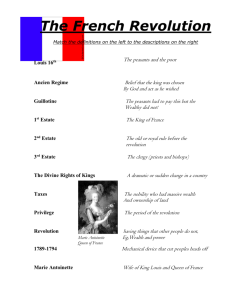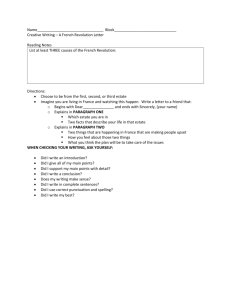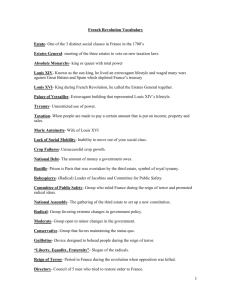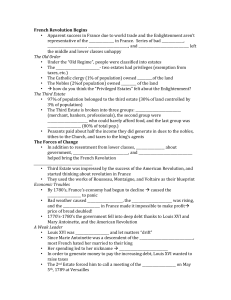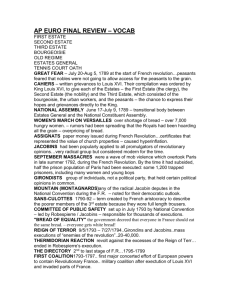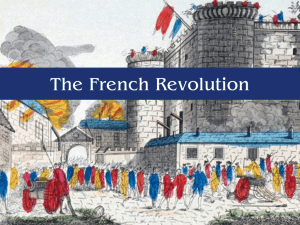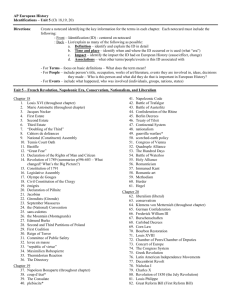French Revolution Q&A: Key Events & Impacts
advertisement
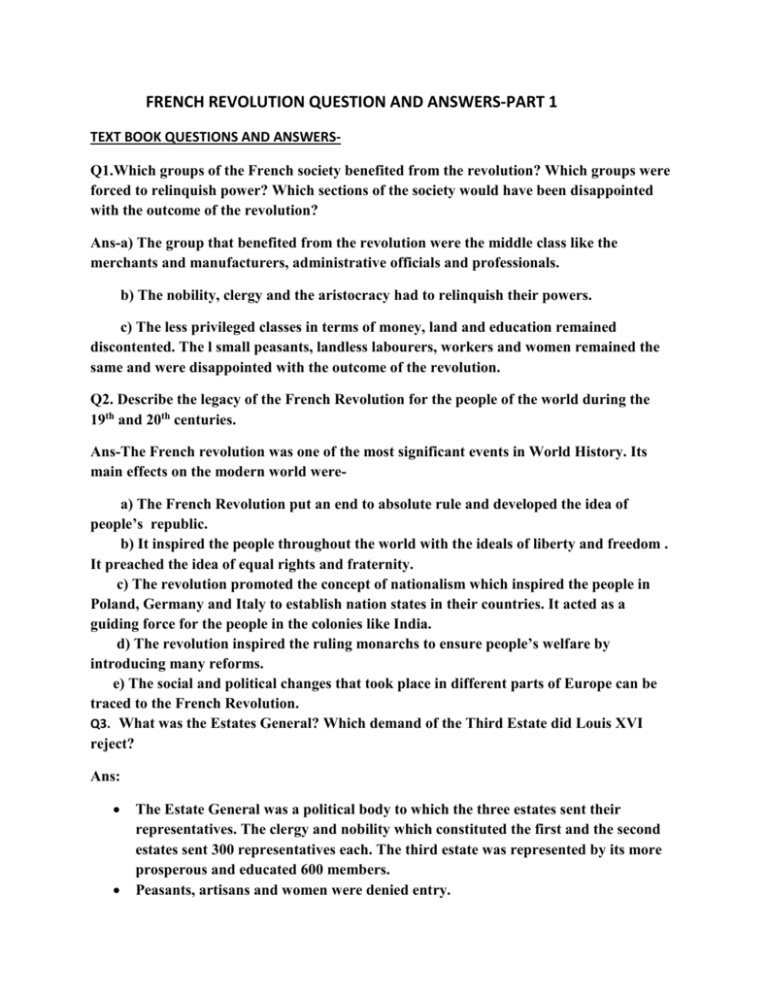
FRENCH REVOLUTION QUESTION AND ANSWERS-PART 1 TEXT BOOK QUESTIONS AND ANSWERSQ1.Which groups of the French society benefited from the revolution? Which groups were forced to relinquish power? Which sections of the society would have been disappointed with the outcome of the revolution? Ans-a) The group that benefited from the revolution were the middle class like the merchants and manufacturers, administrative officials and professionals. b) The nobility, clergy and the aristocracy had to relinquish their powers. c) The less privileged classes in terms of money, land and education remained discontented. The l small peasants, landless labourers, workers and women remained the same and were disappointed with the outcome of the revolution. Q2. Describe the legacy of the French Revolution for the people of the world during the 19th and 20th centuries. Ans-The French revolution was one of the most significant events in World History. Its main effects on the modern world werea) The French Revolution put an end to absolute rule and developed the idea of people’s republic. b) It inspired the people throughout the world with the ideals of liberty and freedom . It preached the idea of equal rights and fraternity. c) The revolution promoted the concept of nationalism which inspired the people in Poland, Germany and Italy to establish nation states in their countries. It acted as a guiding force for the people in the colonies like India. d) The revolution inspired the ruling monarchs to ensure people’s welfare by introducing many reforms. e) The social and political changes that took place in different parts of Europe can be traced to the French Revolution. Q3. What was the Estates General? Which demand of the Third Estate did Louis XVI reject? Ans: The Estate General was a political body to which the three estates sent their representatives. The clergy and nobility which constituted the first and the second estates sent 300 representatives each. The third estate was represented by its more prosperous and educated 600 members. Peasants, artisans and women were denied entry. Voting in the assembly was conducted on the principle of each estate having one vote. The French monarch alone could decide when to call a meeting of this body and it was last convened in the year 1614 before Louis XVI again convened it on 5th May, 1789. The Third Estate wanted voting to be done by the assembly as a whole where each member would have one vote.This demand was rejected by Louis XVI. Q4. Why did Louis XVI accept to a constitution for France? Ans: While the National Assembly was drafting a constitution at Versailles, the rest of France was in turmoil. Agitated by shortage of bread the Parisian mob stormed and destroyed the Bastille. In the countryside rumours spread that the lords of the manor had hired bands of brigands who were on their way to destroy the ripe crops. Overcome with fear, peasants in several districts attacked chateaux armed with hoes and pitchforks. They looted hoarded grain and burnt documents containing records of manorial dues. A large number of nobles fled. Faced with the fear of his revolting subjects, Louis XVI recognized the National Assembly and accepted that his powers would be checked by a constitution. Q5. Who were the Jacobins? Ans: The most successful of the political clubs that were present in France in the revolutionary years were the Jacobins which got its name from the former convent of St Jacob in Paris. The members of the Jacobin club belonged mainly to the less prosperous sections of the French society. like small shopkeepers, artisans such as shoe makers, watch makers etc as well as servants and daily wage workers. The leader of the Jacobins was Maximilian Robespierre. A large group among the Jacobin started wearing long striped trousers to set themselves apart fom the fashionable sections of society, especially nobles, who wore knee breeches. It was a way of demonstrating the end of power exercised by those who wore knee breeches. These Jacobins also wore the red cap that symbolized liberty. Q6. What was the significance of the dress worn by the Jacobins? Ans: A large group among the Jacobin started wearing long striped trousers like the ones worn by dock workers. This was to set themselves apart fom the fashionable sections of society, especially nobles, who wore knee breeches. It was a way of demonstrating the end of power exercised by those who wore knee breeches. These Jacobins came to be known as the sans-culottes meaning those without knee breeches. Sans-culottes men also wore the red cap that symbolized liberty.. Q7.Explain how France abolished the monarchy and became a republic? Ans The National Assembly completed the draft of a Constitution in 1791. It made France a constitutional monarchy by limiting the powers of the monarch. Although Louis XVI signed the Constitution, he entered into secret negotiations with the King of Prussia. The National Assembly voted in April 1792 to declare war against Prussia and Austria. Political clubs became important meeting point for people who wished to discuss government policies and plan their own forms of actions. One of them was the Jacobin Club. Their leader was Maximillian Robespierre. In the summer of 1792 the Jacobins planned a revolt with the Parisians who were angered by the short supplies and high prices of food. On the morning of August 10 they attacked the palace of Tuileries, killed the king’s guards and held the King hostage for several hours. Later the assembly voted to imprison the royal family. Elections were held and from then all men of 21 years and above got the right to vote regardless of wealth. The newly elected Convention abolished the monarchy on 21September,1792and declared France a republic. Louis XVI was sentenced to death by a court for treason and on 21January 1793, the King was publicly executed at the Place de la Concorde. Q8. Why is the Declaration of the Rights of Man and Citizen regarded as a revolutionary document? Ans: 1.This document abolished the privileges and power given to the French feudal classes. 2. It provided the equitable distribution of the burdens of taxation and of rights to public property. 3. The Declaration provided for equality before law and freedom of speech and press. 4. The document was of great revolutionary importance for every government in Europe at the time was based on privilege. Q9. How was the National Assembly formed? What were its main aims? Ans- 1. On 5th May1789, Louis XIV called together an assembly of the Estates General to pass proposals for new taxes. 2. Voting in the Estates General in the past had been conducted according to the principle that each estate had one vote. But members of the third Estate demanded that each member would have one vote. 3. When the King rejected this proposal, the members of the Third Estate walked out of the assembly in protest. 4. The representatives of the Third Estate viewed themselves as the spokesman for the whole French nation. On 20th June , they assembled in the hall of an indoor tennis court on the grounds of Versailles and declared themselves a National Assembly. 5. Their main aim was to draft a constitution for France that would limit the powers of the monarch. 10. What were the main features of the Constitution of 1791? Ans: 1. The Constitution of 1791 made France a constitutional monarchy. Concentration of power gave place to separation of powers between legislature, executive and judiciary. 2. The Constitution of 1791 vested the power to make laws in the National Assembly. 3. The legislative assembly was to be indirectly elected and who belonged to the highest bracket of tax payers, got the right to become the elector and get voted to the National Assembly. The remaining men and all women were classed as passive citizens. 4. The Constitution adopted the Declaration of Rights of Man and Citizen. These rights belonged to each human being by birth and could not be taken away. It was the duty of the State to protect each citizen’s natural rights. ___________________________________________________________________________ ***************************************************************

